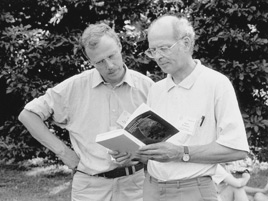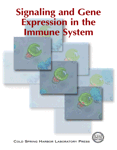|
LXIV: Signaling and Gene Expression in the Immune System 1999 |
|
|

|
From left: Dr. G. Zenke, Dr. Michel Horisberger SYMPOSIUM SYNOPSIS LIST OF PARTICIPANTS CONTENTS OF SYMPOSIUM VOLUME PHOTOGRAPHS PUBLISHED VOLUME  |
Signaling and Gene Expression in the Immune System
1999
Symposium Synopsis
Organizer: Bruce Stillman
The idea for the topic of this Symposium emerged from two separate sources. Over the past decade, understanding of the signal transduction pathways that lie downstream of cytokine action at the cell surface has advanced rapidly. As a consequence, I had imagined that a Symposium on cytokines would be of considerable interest on its own, especially given the medical importance of the topic. At the same time, discussions with Stephen Smale and Rudi Grosschedl one summer during the Cold Spring Harbor Laboratory Gene Expression Course suggested that a Symposium dealing with gene expression in the immune system, an event that lies at the other end of immune cell signaling pathways would be an appropriate choice. The obvious solution was to merge these two interesting topics.
Although this was not meant to be a Symposium covering all aspects of modern immunology, the time was certainly right to hold another meeting on some aspect of immunology in this series, now in its 64th year. The "Antibodies" Symposium in 1967 followed the cracking of the genetic code, itself celebrated in the 1966 Symposium, and naturally focused on immunoglobulin production and amino acid sequence diversity. The "Origins of Lymphocyte Diversity" Symposium in 1976 saw the beginnings of a molecular understanding of antibody variation when Susumu Tonegawa presented his exciting discovery of immunoglobulin gene rearrangements that explained, in large measure, the mechanism of generating B-cell diversity. That meeting, held in the aftermath of the discovery by Doherty and Zinkernagel of MHC restriction, was also in the heyday of T-cell immunology.
It was nearly a decade and a half before the 1989 Symposium on "Immunological Recognition" heralded the understanding at the structural level of antigen presentation and host cell restriction. It was about this time that cytokine research was starting to take off and the concept of Th1 and Th2 T cells appeared. What has emerged since is a complicated, yet fascinating, story about how the immune cell network is controlled, both during development and in the adult. Cytokine signaling and differential gene expression underlie much of modern immunology research. The bringing together of these two apparently separate areas was an experiment that was worth trying. This field has been greatly aided by technologies such as gene deletions and gene replacements in mice, as well as by rapid developments in general understanding of signal transduction and gene expression. If we really grasp how these complex signaling pathways interact and how they can be manipulated, both by extracellular and intracellular means, then medical problems such as inflammation, autoimmunity, and immune system disorders may yield to rational therapy. Manipulating the immune system by such means has long been a goal.
The final program contained 72 oral presentations and 210 poster presentations, making a busy five days for the 445 participants who packed the Grace Auditorium.
I must thank many people for help with organizing such a broad meeting. Particular thanks go to Stephen Smale and Rudi Grosschedl for their generous help in putting this program together. Many thanks to Richard Flavell for agreeing to summarize what looked like an eclectic collection of science. The continued and remarkable help from David Stewart and his staff in the meetings and courses office, particularly Diane Tighe and Mary Smith, makes the organization of these Symposia a pleasure. I also thank my assistant Delia King for her constant help throughout the year with the details required to organize such a meeting.
The efficient staff in the Cold Spring Harbor Laboratory Press, particularly Joan Ebert and Patricia Barker, have ensured that this volume was published in a reasonable time, given the number of authors that they must deal with. We are always dependent on the generous support from federal funding agencies, particularly the National Cancer Institute, which provided funds specifically for the Symposium. Equally important are the corporate sponsors, affiliates, and contributors who support this meeting and the other CSHL meetings, and who are listed on the following page. Without their backing, our strong and broad meetings program would not be as valuable as it is.
Bruce Stillman
February 2000
Search images: